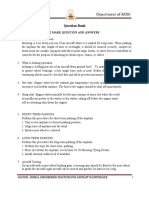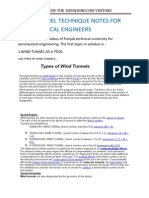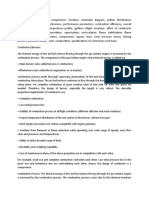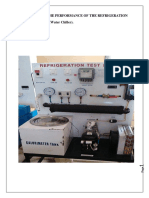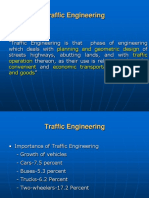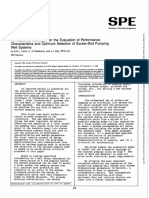2 Marks - U20AE301 AET - DS R2020 - 20210713 - S
2 Marks - U20AE301 AET - DS R2020 - 20210713 - S
Uploaded by
Gurunath AeroCopyright:
Available Formats
2 Marks - U20AE301 AET - DS R2020 - 20210713 - S
2 Marks - U20AE301 AET - DS R2020 - 20210713 - S
Uploaded by
Gurunath AeroOriginal Title
Copyright
Available Formats
Share this document
Did you find this document useful?
Is this content inappropriate?
Copyright:
Available Formats
2 Marks - U20AE301 AET - DS R2020 - 20210713 - S
2 Marks - U20AE301 AET - DS R2020 - 20210713 - S
Uploaded by
Gurunath AeroCopyright:
Available Formats
Department of Aeronautical / Aerospace Engineering
U20AE301 | Aero Engineering Thermodynamics
2 Marks Questions with Answers
Unit – I Basic Concept and First Law
1. What is meant by Thermodynamics system? How do you classify it?
A quantity of the matter or part
of the space which is under
thermodynamic study is called as
system. There are three types of
system:
i. closed system,
ii. open system and
iii. isolated system.
2. Discuss briefly about thermodynamic system and its types.
A quantity of the matter or part of the space which is under thermodynamic
study is called as system. There are three types of system: closed system, open system
and isolated system
Closed system: The system of fixed mass across the boundary of which no mass
transfer can take place is called as closed system. However, across the closed system
the energy transfer may take place. An example is fluid being compressed by the piston
in cylinder.
Open system: The system across the boundary of which transfer of both mass as well
as energy can take place across the boundary is called as open system. An example is
an air compressor.
Isolated system: The system in which both the mass as well as energy content remains
constant is called an isolated system. In this system, no mass or energy transfer takes
place across the boundary. An example is a cup of tea inside a room.
Dhanalakshmi Srinivasan Engineering College (Autonomous), Perambalur – 621 212. DS R2020
3. Define extensive and intensive property.
Extensive properties of system: The properties of the system that depend on the mass
or quantity of the system are called extensive properties. Some examples of extensive
properties are: mass, volume, enthalpy, internal energy, entropy etc.
Intensive properties of the system: These properties do not depend on the quantity of
matter of the system. Some of the examples of intensive properties are: freezing point
temperature, boiling point, temperature of the system, density, specific volume etc.
4. What is meant by a thermal energy reservoir? (R08, Apr/May 2015), (R08, Nov/Dec 2016)
A thermal reservoir is a large system from
which a finite quantity of energy can be
extracted as heat or to which a finite quantity of
energy can be added as heat without changing
its temperature.
Example: Bodies with relatively large
thermal masses can be modelled as thermal
energy reservoirs.
5. When is work said to be done by a system?
The first law of thermodynamics says that 𝑄 − 𝑊 = ∆𝑈. If the net workdone is
positive, it is said that the work is done by the system.
6. What are point and path functions? Give examples. (R13, Apr/May 2015)
Point Function: They depend on the state only,
and not on how a system reaches that state. All
properties are point functions. Example:
Pressure (p), Temperature (T), Volume (V).
Path Function: Their magnitudes depend on the
path followed during a process as well as the end
states. Example: Internal energy (U), Heat
Transfer (Q), Work (W).
7. State – First law of thermodynamics.
It says that energy can neither be created nor it can be destroyed though it can
be converted from one form to the other.
Gurunath Kaliyaperumal – U20AE301 Aero Engineering Thermodynamics | 2
Dhanalakshmi Srinivasan Engineering College (Autonomous), Perambalur – 621 212. DS R2020
8. What is meant by Thermodynamic Substance and Thermometric Property?
Properties of substances are things such as mass, temperature, volume, and
pressure. The state of a system at equilibrium is defined by the values of its
thermodynamic properties.
These thermodynamic properties are used to define the current state of a
thermodynamic substance.
9. State the Zeroth law of thermodynamics. (R08, Apr/May 2017), (R08, Nov/Dec 2015)
The Zeroth law of thermodynamics states
that if two bodies are in thermal equilibrium with a
third body, they are also in thermal equilibrium with
each other.
For example, if temperature of body A is
equal to temperature of body C and temperature of
body B is also equal to temperature of body C, then
temperature of body A is equal to that of B.
10. When a system is said to be in “Thermodynamic Equilibrium”?
When a system satisfies the condition for all modes of equilibrium, it is said to
be in thermodynamic equilibrium.
11. What do you mean by quasi-static process? (R13, Apr/May 2019)
Quasi-static process is a locus of the thermodynamic process that happens
slowly enough for the system to remain in internal equilibrium.
Gurunath Kaliyaperumal – U20AE301 Aero Engineering Thermodynamics | 3
Dhanalakshmi Srinivasan Engineering College (Autonomous), Perambalur – 621 212. DS R2020
12. Compare Heat and Work. (R08, Apr/May 2015), (R08, Nov/Dec 2016)
Work (W) Heat (Q)
Interaction Mechanical Thermal
Requires Force and Displacement Temperature difference
Process Macroscopic pushes and pulls Microscopic collisions
A system is in mechanical A system is in thermal
equilibrium when there is no net equilibrium when it is at the
Equilibrium
force or torque on it. same temperature as the
environment.
13. Derive specific heat capacity at constant pressure and constant volume.
We know that
𝐶𝑝
𝑅 = 𝐶𝑝 − 𝐶𝑣 𝛾=
𝐶𝑣
Specific heat at constant pressure Specific heat at constant volume
𝑅 = 𝐶𝑝 − 𝐶𝑣 𝑅 = 𝐶𝑝 − 𝐶𝑣
𝐶𝑣 𝐶𝑝
𝑅 = 𝐶𝑝 (1 − ) 𝑅 = 𝐶𝑣 ( − 1)
𝐶𝑝 𝐶𝑣
1 𝑅 = 𝐶𝑣 (𝛾 − 1)
𝑅 = 𝐶𝑝 (1 − )
𝛾 𝑅
𝐶𝑣 =
𝛾−1 𝛾−1
𝑅 = 𝐶𝑝 ( )
𝛾
𝛾𝑅
𝐶𝑝 =
𝛾−1
14. What are the limitations of the first law of thermodynamics? (R13, Nov/Dec 2016)
The limitations of first law:
It does not specify the direction of the process. All spontaneous processes
processed in one direction only.
It does not deny the feasibility of a process reversing itself.
Gurunath Kaliyaperumal – U20AE301 Aero Engineering Thermodynamics | 4
Dhanalakshmi Srinivasan Engineering College (Autonomous), Perambalur – 621 212. DS R2020
And it does not provide answers to the following questions.
to what extent does the process / reaction proceed?
is a particular process / reaction feasible?
is complete conversion of internal energy into work possible?
15. Define indicated power and brake power of an engine.
Indicated Power (𝑖𝑝) is defined as the power developed by combustion of fuel
in the engine cylinder. It is always more than brake power.
(𝑖𝑚𝑒𝑝)𝐿𝐴𝑛𝐾 𝑝𝑉𝑁𝐾
𝑖𝑝 = =
60 × 1000 60
The power developed by an engine and measured at the output shaft is called
the brake power (𝑏𝑝).
(𝑏𝑚𝑒𝑝)𝐿𝐴𝑛𝐾 2𝜋𝑁𝑇
𝑏𝑝 = =
60 × 1000 60
16. Indicate the practical application of steady flow energy equation. (R13, Nov/Dec 2016)
Diffuser, discharges fluid with higher enthalpy. The velocity of the fluid is
reduced.
Compressors, discharge the fluid with higher enthalpy, i.e, with higher
pressure and temperature.
Turbine, converts enthalpy into useful work.
Nozzle, primarily used to increase the flow velocity.
A heat exchanger is a system used to transfer heat between two or more fluids.
Unit – II Second Law and Entropy
17. What is meant by perpetual motion of machine second kind? (R13, Nov/Dec 2016)s
A device that violates the second
law of thermodynamics is called a
perpetual motion machine of the second
kind (PMM2).
Gurunath Kaliyaperumal – U20AE301 Aero Engineering Thermodynamics | 5
Dhanalakshmi Srinivasan Engineering College (Autonomous), Perambalur – 621 212. DS R2020
18. State the Kelvin – Planck statement of second law of Thermodynamics.
It is impossible for any device that operates on a cycle to exchange heat with
just a single reservoir and produce a net amount of work.
Kelvin – Planck statement
19. State the Clausius statement of second law of Thermodynamics.
It is impossible to construct a device that operates on a cycle and produces no
effect other than the transfer of heat from a low temperature body to a high temperature
body.
Clausius statement
Gurunath Kaliyaperumal – U20AE301 Aero Engineering Thermodynamics | 6
Dhanalakshmi Srinivasan Engineering College (Autonomous), Perambalur – 621 212. DS R2020
20. State the Clausius Inequality theorem and what its inference is?
The Clausius theorem states that for a system exchanging heat with external
reservoirs is undergoing a cyclic process.
𝑑𝑄
∮ ≤0
𝑇
For irreversible processes,
𝑑𝑄𝑖𝑟𝑟𝑒𝑣
∮ <0
𝑇
For reversible processes,
𝑑𝑄𝑟𝑒𝑣
∮ =0
𝑇
Thus, the Clausius Inequality is a consequence of applying the second law of
thermodynamics at each infinitesimal stage of heat transfer.
21. Define the Coefficient of Performance for a Refrigerator.
The efficiency of a refrigerator is
expressed in terms of the coefficient of
performance (COP), denoted by COPRef.
It is the ratio between heat (QL) removed
from the refrigerated space to the work
(Wnet,in) requires to accomplish it.
22. Write the expression for COP of a heat pump and a refrigerator.
Heat Pump Refrigerator
𝐷𝑒𝑠𝑖𝑟𝑒𝑑 𝑂𝑢𝑡𝑝𝑢𝑡 𝐷𝑒𝑠𝑖𝑟𝑒𝑑 𝑂𝑢𝑡𝑝𝑢𝑡
𝐶𝑂𝑃𝐻𝑃 = 𝐶𝑂𝑃𝑅𝑒𝑓 =
𝑅𝑒𝑞𝑢𝑖𝑟𝑒𝑑 𝐼𝑛𝑝𝑢𝑡 𝑅𝑒𝑞𝑢𝑖𝑟𝑒𝑑 𝐼𝑛𝑝𝑢𝑡
𝐻𝑒𝑎𝑡𝑖𝑛𝑔 𝐸𝑓𝑓𝑒𝑐𝑡 𝐶𝑜𝑜𝑙𝑖𝑛𝑔 𝐸𝑓𝑓𝑒𝑐𝑡
𝐶𝑂𝑃𝐻𝑃 = 𝐶𝑂𝑃𝑅𝑒𝑓 =
𝑊𝑜𝑟𝑘 𝐼𝑛𝑝𝑢𝑡 𝑊𝑜𝑟𝑘 𝐼𝑛𝑝𝑢𝑡
𝑄𝐻 𝑄𝐿
𝐶𝑂𝑃𝐻𝑃 = 𝐶𝑂𝑃𝑅𝑒𝑓 =
𝑊𝑛𝑒𝑡,𝑖𝑛 𝑊𝑛𝑒𝑡,𝑖𝑛
Gurunath Kaliyaperumal – U20AE301 Aero Engineering Thermodynamics | 7
Dhanalakshmi Srinivasan Engineering College (Autonomous), Perambalur – 621 212. DS R2020
23. Prove that COPHP = COPRef + 1.
𝑄𝐻 𝑄𝐻
𝐶𝑂𝑃𝐻𝑃 = =
𝑊𝑛𝑒𝑡,𝑖𝑛 𝑄𝐻 − 𝑄𝐿
𝑄𝐻 𝑄𝐻 − (𝑄𝐻 − 𝑄𝐿 )
𝐶𝑂𝑃𝐻𝑃 − 1 = −1 =
𝑄𝐻 − 𝑄𝐿 𝑄𝐻 − 𝑄𝐿
𝑄𝐻 − 𝑄𝐻 + 𝑄𝐿
𝐶𝑂𝑃𝐻𝑃 − 1 =
𝑄𝐻 − 𝑄𝐿
𝑄𝐿
𝐶𝑂𝑃𝐻𝑃 − 1 = = 𝐶𝑂𝑃𝑅𝑒𝑓
𝑄𝐻 − 𝑄𝐿
𝐶𝑂𝑃𝐻𝑃 = 𝐶𝑂𝑃𝑅𝑒𝑓 + 1
24. What are the difference between a Heat pump and Refrigerator?
Heat pump is to maintain a heated space at a high temperature.
Refrigerator is to maintain a refrigerated space at a low temperature.
Heat Pump Refrigerator
25. State the Clausius’ theorem.
The cyclic integral of 𝑑𝑄/𝑇 for e reversible cycle is equal to zero. This is
known as Clausius’ theorem.
𝑑𝑄
∮ =0
𝑅 𝑇
26. Define the term entropy.
Classical Thermodynamics Statistical Thermodynamics
Entropy is a property designated S Entropy can be viewed as a measure
𝛿𝑄 of molecular disorder, or molecular
and is defined as 𝑑𝑆 = ( ) .
𝑇 𝑖𝑛𝑡 𝑟𝑒𝑣 randomness.
Gurunath Kaliyaperumal – U20AE301 Aero Engineering Thermodynamics | 8
Dhanalakshmi Srinivasan Engineering College (Autonomous), Perambalur – 621 212. DS R2020
27. What is principle of entropy?
Consider a cycle that is made up of two processes: process 1-2, which is arbitrary
(reversible or irreversible), and process 2-1, which is internally reversible, as shown in
Figure. From the Clausius inequality,
𝛿𝑄
∮ ≤0
𝑇
or
2 1
𝛿𝑄 𝛿𝑄
∫ +∫ ( ) ≤0
1 𝑇 2 𝑇 𝑖𝑛𝑡. 𝑟𝑒𝑣.
The second integral in the previous relation is recognized as the entropy change
𝑆1 − 𝑆2. Therefore,
2
𝛿𝑄
∫ + (𝑆1 − 𝑆2 ) ≤ 0
1 𝑇
which can be rearranged as
2
𝛿𝑄
∫ ≤ (𝑆2 − 𝑆1 )
1 𝑇
2
𝛿𝑄
(𝑆2 − 𝑆1 ) ≥ ∫
1 𝑇
It can also be expressed in differential form as
2
𝛿𝑄
𝑑𝑆 ≥ ∫
1 𝑇
28. What are the causes of entropy increase?
When a solid becomes a liquid, its entropy increases.
When a liquid becomes a gas, its entropy increases.
As a gas expands in a system, entropy increases.
Any chemical reaction that increases the number of gas molecules also increases
entropy.
29. What are the important characteristics of entropy?
It increases when the heat is supplied irrespective of the fact whether
temperature changes or not.
Whether temperature changes or not the entropy decreases when heat is
rejected.
In all the adiabatic processes, the entropy remains constant.
Gurunath Kaliyaperumal – U20AE301 Aero Engineering Thermodynamics | 9
Dhanalakshmi Srinivasan Engineering College (Autonomous), Perambalur – 621 212. DS R2020
Unit – III Air Standard Cycles
26. What are the assumptions in air standard cycle? (R08, Apr/May 2015)
The air- standard assumptions:
i. The working fluid is air, which continuously circulates in a closed loop (cycle).
Air is considered as ideal gas.
ii. All the processes in (ideal) power cycles are internally reversible.
iii. Combustion process is modelled by a heat-addition process from an external
source.
iv. The exhaust process is modelled by a heat-rejection process that restores the
working fluid (air) at its initial state.
27. How does the change in compression ratio affect the air standard efficiency of an ideal
Otto Cycle? (R13, Nov/Dec 2016)
28. Write the effect of compression ratio on engine thermal efficiency of an Otto cycle with
a suitable graph. (R13, Apr/May 2015)
The increase in compression
ratio increases the efficiency of an ideal
Otto cycle.
We can observe from Figure
that the thermal efficiency curve is
rather steep at low compression ratios
but flattens out starting with a
compression ratio value of about 8.
Therefore, the increase in thermal
efficiency with the compression ratio is
not as pronounced at high compression
ratios.
29. Sketch the T-s diagram and p-v diagram of Otto cycle. (R08, Apr/May 2015)
Gurunath Kaliyaperumal – U20AE301 Aero Engineering Thermodynamics | 10
Dhanalakshmi Srinivasan Engineering College (Autonomous), Perambalur – 621 212. DS R2020
30. Draw the p-v and T-s diagram for Brayton cycle. (R13, Apr/May 2017)
31. What is an air standard efficiency and relative efficiency? [(R08, Nov/Dec 2015);
(R08, Nov/Dec 2016)]
Air standard efficiency: When the engine is working with air as the medium, then the
efficiency of the engine is said to be air standard efficiency.
Relative efficiency: Relative efficiency is the ratio between actual thermal efficiency
and air standard efficiency.
32. State the four processes of the Diesel cycle. (R08, Apr/May 2017)
The cycle consists of four internally reversible processes in series.
1–2 isentropic compression.
2–3 constant pressure heat addition.
3–4 isentropic expansion.
4–1 constant volume heat rejection.
33. Define mean effective pressure. [(R08, Nov/Dec 2015); (R08, Nov/Dec 2016)]
34. What is mean effective pressure? How is it calculated? (R13, Apr/May 2015)
Gurunath Kaliyaperumal – U20AE301 Aero Engineering Thermodynamics | 11
Dhanalakshmi Srinivasan Engineering College (Autonomous), Perambalur – 621 212. DS R2020
35. What is the significance of mean effective pressure? (R08, Apr/May 2015)
The mean effective pressure (MEP)
is a fictitious pressure that, if it acted on the
piston during the entire power stroke, would
produce the same amount of net work as that
produced during the actual cycle.
That is,
𝑊𝑛𝑒𝑡 = 𝑀𝐸𝑃 × 𝑃𝑖𝑠𝑡𝑜𝑛 𝑎𝑟𝑒𝑎 × 𝑆𝑡𝑟𝑜𝑘𝑒
= 𝑀𝐸𝑃 × 𝐷𝑖𝑠𝑝𝑙𝑎𝑐𝑒𝑚𝑒𝑛𝑡 𝑣𝑜𝑙𝑢𝑚𝑒
Therefore,
𝑊𝑛𝑒𝑡
𝑀𝐸𝑃 =
𝑉𝑚𝑎𝑥 − 𝑉𝑚𝑖𝑛
The engine with a larger value of
MEP delivers more net work per cycle and
thus performs better.
36. Differentiate between energy and exergy. (R13, Apr/May 2017)
Energy Exergy
Energy is neither created nor destroyed Exergy is always destroyed when a
during a process. process is irreversible, for example loss
of heat to the environment.
Energy changes from one form to This destruction is proportional to the
another. entropy increase of the system together
with its surroundings.
37. What is meant by specific steam consumption in a Rankine cycle?
(R08, Apr/May 2015)
The rate of steam flow required to produce unit shaft output is called the specific
steam consumption.
3600 𝑘𝑔
𝑆𝑆𝐶 = 𝑆𝑡𝑒𝑎𝑚 𝑟𝑎𝑡𝑒 =
𝑊𝑇 − 𝑊𝑃 𝑘𝑊 − ℎ𝑟
38. What is the difference between saturated liquid and compressed liquid?
(R13, Apr/May 2015)
Saturated liquid is a type of liquid in which no kind of solute can be added for
that temperature while compressed.
Compressed liquids have more open vacancies for compression while in
saturation no solute can be added or compressed.
Gurunath Kaliyaperumal – U20AE301 Aero Engineering Thermodynamics | 12
Dhanalakshmi Srinivasan Engineering College (Autonomous), Perambalur – 621 212. DS R2020
39. State the advantages of regenerative cycle/simple Rankine cycle.
(R13, Apr/May 2017)
Advantages of regenerative power cycle:
The heating process in the boiler tends to become reversible.
The thermal stresses in the boiler are minimized. This is due to the inlet
temperature is increased so that the temperature difference is less in the boiler.
The thermal efficiency is improved because average temperature of heat
addition to the cycle is increased.
The Heating rate is reduced.
The LP turbine blade height can be reduced because steam flow at lower stage
is reduced.
The steam condenser size can be reduced.
The turbine efficiency increases and damage to the turbine is less.
40. Draw and explain a p-T diagram for a pure substance. (R13, Apr/May 2017)
The following is the P-T diagram of a pure substance and is often called the
phase diagram since all three phases are separated from each other by three lines. The
sublimation line separates the solid and vapor regions, the vaporization line separates
the liquid and vapor regions, and the melting (or fusion) line separates the solid and
liquid regions.
41. What are the advantages and disadvantages of reheating? (R13, Nov/Dec 2016)
Advantages Disadvantages
The reheating is essential in high The cost of the extra pipes,
pressure modern thermal power equipment and controls make the
plants to increase the lifetime of the cycle more expensive than the
plant. normal Rankine cycle.
Gurunath Kaliyaperumal – U20AE301 Aero Engineering Thermodynamics | 13
Dhanalakshmi Srinivasan Engineering College (Autonomous), Perambalur – 621 212. DS R2020
The reheating reduces 4 to 5% fuel The greater floor space is reduced to
consumption with a corresponding accommodate the longer turbine and
reduction in the fuel handling reheat piping
The reheat cycle reduces the steam The complexity of the operation and
flow of 15 to 20% with corresponding control increases with the adoption of
reduction in the boiler, turbine and the reheat cycle in thermal power
feed handling equipment capacities. plant.
This also reduces the pumping power All the lighter loads, the steam
in that proportion. passing through the last blade rows to
The wetness of the exhaust steam the condenser are seriously super-
with the reheat cycle is reduced to heated if the same reheat is
50% of the Rankine cycle with a maintained. Feed water is sometimes
corresponding reduction in the sprayed into the low-pressure
exhaust blade erosion. cylinders as low steam flows as a
A reduction in the steam volume and precaution against
heat to the condenser is reduced by 7 over-heating of blades.
to 8%. Therefore, the condenser size
and cooling water requirement are
also reduced by the same proportion.
The size of the Low pressure (LP)
turbine blades is reduced because
specific volume is reduced by 7 to
8%.
42. What is triple point? What are the values of temperature and pressure of water at triple
point? (R13, Nov/Dec 2016)
The temperature and pressure at which a substance can exist in equilibrium in
the liquid, solid, and gaseous states is called the triple point.
Gurunath Kaliyaperumal – U20AE301 Aero Engineering Thermodynamics | 14
Dhanalakshmi Srinivasan Engineering College (Autonomous), Perambalur – 621 212. DS R2020
43. What is the difference between the critical point and the triple point?
(R13, Apr/May 2015)
Critical Point Triple Point
Critical Point of a substance lies at the Triple point is the point where the three
endpoint of the phase equilibrium curve. equilibrium curves meet.
Temperature corresponding to the triple
Critical temperature is usually higher
point is usually lower than the standard
than the standard temperature.
temperature
Pressure is generally higher than the Pressure is generally lower than the
standard pressure. standard pressure.
Only liquid and gaseous phases can All Solid, liquid, and gaseous phases can
coexist in equilibrium. coexist in equilibrium.
Unit – V Basics of Propulsion and Heat Transfer
44. What is specific impulse? How is it calculated? (R13, Apr/May 2015)
45. What is specific impulse? Also state its significance. (R13, Apr/May 2017)
The thrust per unit mass flow rate of air is called as specific impulse, Isp.
𝑇 𝑚̇𝑎 (𝑣𝑒 − 𝑣𝑖 )
𝐼𝑠𝑝 = = = (𝑣𝑒 − 𝑣𝑖 )
𝑚̇𝑎 𝑚̇𝑎
The thrust is directly proportional to the specific impulse.
46. How will you classify propulsive engine? (R13, Nov/Dec 2016)
Gurunath Kaliyaperumal – U20AE301 Aero Engineering Thermodynamics | 15
Dhanalakshmi Srinivasan Engineering College (Autonomous), Perambalur – 621 212. DS R2020
47. What are air breathing and non-air breathing engines? Give examples.
There are two general types of propulsion namely, air-breathing and non-air-
breathing engines.
Air-breathing engines use oxygen from the atmosphere in the combustion of
fuel. They include the turbojet, turboprop, ramjet, and pulse-jet.
Non-air-breathing engines carry an oxygen supply. They can be used both in
the atmosphere and in outer space. They are commonly called rockets and are of two
kinds liquid-propellant and solid-propellant.
48. What are Nozzles and Diffusers? (R08, Nov/Dec 2016)
A nozzle is a device which A diffuser is a device which
accelerates fluid. During this process, slows down fluid. That means, velocity
velocity of fluid increases with of fluid decreases with increasing
decreasing pressure. pressure.
49. Define Mach number and state the condition for subsonic flow. (R08, Nov/Dec 2016)
The ratio of the velocity of a body to the speed of sound in the surrounding
medium.
𝑣
𝑀=
𝑎
If the Mach number is < 1, the flow speed is lower than the speed of sound - and
the speed is subsonic.
50. Define and give mathematical expressions for thrust power. (R08, Apr/May 2017)
The product of thrust and inlet velocity of air is called thrust power.
𝑃𝑇 = 𝑇 × 𝑣𝑖 = 𝑚̇𝑖 (𝑣𝑒 − 𝑣𝑖 ) × 𝑣𝑖
51. Define propulsive power and propulsive efficiency.
Propulsive power
It is given by the net increase in the energy of the working fluid between inlet
and exit.
1
𝑃𝑃 = 𝑚̇𝑖 (𝑣𝑒2 − 𝑣𝑖2 )
2
Gurunath Kaliyaperumal – U20AE301 Aero Engineering Thermodynamics | 16
Dhanalakshmi Srinivasan Engineering College (Autonomous), Perambalur – 621 212. DS R2020
Propulsive efficiency
It is the ratio of the thrust power to the propulsive power.
𝑃𝑇 𝑚̇𝑖 (𝑣𝑒 − 𝑣𝑖 ) × 𝑣𝑖 2𝑚̇𝑖 (𝑣𝑒 − 𝑣𝑖 ) × 𝑣𝑖 2𝑣𝑖
𝜂𝑃 = = = =
𝑃𝑃 1 2 2 𝑚̇𝑖 (𝑣𝑒 + 𝑣𝑖 )(𝑣𝑒 − 𝑣𝑖 ) (𝑣𝑒 + 𝑣𝑖 )
2 𝑚̇𝑖 (𝑣𝑒 − 𝑣𝑖 )
52. What do you understand by chocking in nozzle flows?
Choked flow is a phenomenon
that limits the mass flow rate of a
compressible fluid flowing through
nozzles, orifices and sudden
expansions where M=1.
The establishment of choked
flow can be identified as the point at
which the ratio of the minimum fluid
pressure to inlet pressure (Pmin/P1)
falls below the critical pressure ratio
in the fluid.
53. Define critical pressure ratio and super saturated flow with reference to flow through a
steam nozzle.
Critical Pressure Ratio (CPR):
There is only one value of the ratio P2/P1, which produces maximum discharge
from the nozzle.
Saturated Flow through Nozzle:
When dry saturated steam is expanded adiabatically, or isentropically, it
becomes wet and is shown by a vertical line on Mollier diagram.
54. Mention the modes of heat transfer.
There are three modes of heat transfer namely conduction, convection and
radiation.
Conduction: Conduction refers to the heat transfer that occurs across the medium.
Medium can be solid or a fluid.
Convection: Convection refers to the heat transfer that will occur between a surface and
a moving fluid when they are at different temperatures.
Radiation: In radiation, in the absence of intervening medium, there is net heat transfer
between two surfaces at different temperatures in the form of electromagnetic waves.
Gurunath Kaliyaperumal – U20AE301 Aero Engineering Thermodynamics | 17
Dhanalakshmi Srinivasan Engineering College (Autonomous), Perambalur – 621 212. DS R2020
55. State the Fourier’s law of conduction.
The rate of loss of heat by a body is directly proportional to the temperature
gradient.
𝑑𝑄 𝐴(𝑇𝑡 − 𝑇𝑠 )
∝
𝑑𝑡 𝑑𝑥
Where
Tt is the temperature at time t.
Ts is the temperature of the surrounding.
56. Define thermal conductivity.
Thermal conductivity is the ability of any material to be heated or to be cooled
or capacity to pass heat.
57. What are the factors affecting the thermal conductivity? (R13, Nov/Dec 2016)
Free electrons Pressure
Purity of material Density
Effect of forming Crystalline structure
High temperature
58. State the Newton’s law of cooling.
The rate of loss of heat by a body is directly proportional to the temperature
difference between system and surroundings, provided the difference is small.
𝑑𝑄
∝ 𝐴(𝑇𝑡 − 𝑇𝑠 )
𝑑𝑡
Where
Tt is the temperature at time t.
Ts is the temperature of the surrounding.
59. Mention some applications of radiation heat transfer. (R13, Apr/May 2017)
Clothes
Radiators
Room (electric) heaters
Cooking utensils
60. What is thermal radiation? How does it differ from electromagnetic radiation? (R13,
Apr/May 2015)
Thermal radiation is generated by the thermal motion of particles in matter.
Particle motion results in charge-acceleration or dipole oscillation which produces
electromagnetic radiation.
Gurunath Kaliyaperumal – U20AE301 Aero Engineering Thermodynamics | 18
You might also like
- Aero Engineering Thermodynamics PDFDocument22 pagesAero Engineering Thermodynamics PDFSridharanNo ratings yet
- Ae-2405 Aircraft Systems LaboratoryDocument42 pagesAe-2405 Aircraft Systems LaboratorycalinshabuNo ratings yet
- SchlierenDocument14 pagesSchlierenPhani Kiran VadlamaniNo ratings yet
- Steady Aircraft Flight and PerformanceFrom EverandSteady Aircraft Flight and PerformanceRating: 5 out of 5 stars5/5 (2)
- Marine-Offshore Cable & Pipe Penetration DossierDocument39 pagesMarine-Offshore Cable & Pipe Penetration DossierHonka VoxNo ratings yet
- Department of Aeronautical / Aerospace Engineering U20AE301 - Aero Engineering Thermodynamics 50 Big QuestionsDocument8 pagesDepartment of Aeronautical / Aerospace Engineering U20AE301 - Aero Engineering Thermodynamics 50 Big QuestionsGurunath AeroNo ratings yet
- Question Bank: 2 Mark Question and AnswersDocument11 pagesQuestion Bank: 2 Mark Question and Answersraj6062No ratings yet
- Aero Engineering Thermodynamics 14Document45 pagesAero Engineering Thermodynamics 14BIBIN CHIDAMBARANATHANNo ratings yet
- An Autonomous InstituteDocument80 pagesAn Autonomous InstituteayeshaNo ratings yet
- AE6002 Aircraft General Engineering and Maintenance PracticesDocument1 pageAE6002 Aircraft General Engineering and Maintenance PracticesKarthi Keyan50% (2)
- AE3302 ASI SyllabusDocument1 pageAE3302 ASI Syllabussudhakar2010100% (1)
- Aerospace Propulsion Dept of ANE, MRCET: 2.1:euler's Turbo-Machinery EquationsDocument31 pagesAerospace Propulsion Dept of ANE, MRCET: 2.1:euler's Turbo-Machinery EquationssushmarajagopalNo ratings yet
- Ae2254 QBDocument13 pagesAe2254 QBMahesh J RaoNo ratings yet
- Industrial AerodynamicsDocument78 pagesIndustrial AerodynamicsAnuNo ratings yet
- 100 Years of Vortex Theory PDFDocument25 pages100 Years of Vortex Theory PDFManuel ZúñigaNo ratings yet
- Aerodynamics Chapter 1 RDocument25 pagesAerodynamics Chapter 1 RYadana1No ratings yet
- Methods of Cooling in Liquid RocketDocument5 pagesMethods of Cooling in Liquid RocketrachelNo ratings yet
- Flight Dynamics 2 Marks by Nambi RajanDocument4 pagesFlight Dynamics 2 Marks by Nambi RajanNambi RajanNo ratings yet
- Srinivasan Engineering College, Perambalur Department of Aeronautical Engineering Ae 1014 Air Traffic Control and Aerodrome DesignDocument10 pagesSrinivasan Engineering College, Perambalur Department of Aeronautical Engineering Ae 1014 Air Traffic Control and Aerodrome Designmurjass85No ratings yet
- AGEMPDocument12 pagesAGEMPAravind Phoenix67% (3)
- Landing Gear Slide Chapter 3Document35 pagesLanding Gear Slide Chapter 3mellon3duwen100% (1)
- Propulsion Systems I: Dr. Oğuz UzolDocument37 pagesPropulsion Systems I: Dr. Oğuz UzolMudassir IqbalNo ratings yet
- AET Question Bank For AUC R2013 - SDocument5 pagesAET Question Bank For AUC R2013 - SGurunath AeroNo ratings yet
- Esa 2 Mark Q & Answer PDFDocument11 pagesEsa 2 Mark Q & Answer PDFChadwickajiNo ratings yet
- Wind Tunnel Technique Notes For Aeronautical Engineers TP 1Document2 pagesWind Tunnel Technique Notes For Aeronautical Engineers TP 1Adarsh KumarNo ratings yet
- Air Breathing Propulsion Unit-2Document54 pagesAir Breathing Propulsion Unit-2api-271354682No ratings yet
- Elements of Aeronautics Unit 1Document16 pagesElements of Aeronautics Unit 1VikasVickyNo ratings yet
- Aero Engineering ThermodynamicsDocument4 pagesAero Engineering Thermodynamicsக.கணேஷ் குமார்No ratings yet
- MIDTERM Lesson 1 MSGDocument24 pagesMIDTERM Lesson 1 MSGJohn Ericsson RobariosNo ratings yet
- BURNER: Burners-Types, Components - Function, Schematic Diagram, Airflow DistributionDocument14 pagesBURNER: Burners-Types, Components - Function, Schematic Diagram, Airflow DistributionSushma RajagopalNo ratings yet
- Unit 1 Module 2 Air Data InstrumentsDocument37 pagesUnit 1 Module 2 Air Data InstrumentsVeena Divya Krishnappa100% (1)
- AE 6009 - Industrial Aerodynamics 2 MARKS & 16 MARKSDocument166 pagesAE 6009 - Industrial Aerodynamics 2 MARKS & 16 MARKSSrinivasan MuthuvelNo ratings yet
- Iii Mech Vi Sem QB 2013 2014 Even PDFDocument137 pagesIii Mech Vi Sem QB 2013 2014 Even PDFSiva RamanNo ratings yet
- Topic No-11 AIRCRAFT OXYGEN REQUIREMENTDocument9 pagesTopic No-11 AIRCRAFT OXYGEN REQUIREMENTSamarth SNo ratings yet
- Stablity, Control and LimitationsDocument359 pagesStablity, Control and LimitationsgadisaNo ratings yet
- Physics FormulasDocument2 pagesPhysics FormulasSuchetana DasNo ratings yet
- Aircraft Landing Gear System: Presented By: Rishikesh K. Singh Roll No. 134103054 Guided by Dr. Ujjwal Kumar SahaDocument39 pagesAircraft Landing Gear System: Presented By: Rishikesh K. Singh Roll No. 134103054 Guided by Dr. Ujjwal Kumar SahaindahNo ratings yet
- Aero Engine Maintenance and RepairDocument21 pagesAero Engine Maintenance and RepairDurai Raj KumarNo ratings yet
- Unit I Introduction To Design For Static StrengthDocument47 pagesUnit I Introduction To Design For Static StrengthSanketHedduri0% (2)
- Rr312102 Aircraft PerformanceDocument8 pagesRr312102 Aircraft PerformanceSrinivasa Rao GNo ratings yet
- Design ConstructionDocument157 pagesDesign ConstructionfarahNo ratings yet
- Agemp Model 2 ANSWER KEYDocument13 pagesAgemp Model 2 ANSWER KEYAnonymous P0rZmU100% (2)
- Exhaustive Question Bank-AMDocument5 pagesExhaustive Question Bank-AMaerolab instructor100% (1)
- Module Exam Application Form PDFDocument10 pagesModule Exam Application Form PDFBazli UmarNo ratings yet
- Aircraft Structures I: Lecture Notes OnDocument23 pagesAircraft Structures I: Lecture Notes OnCjananiNo ratings yet
- Flight Dynamics - Stability (General)Document33 pagesFlight Dynamics - Stability (General)Rajesh Kancheti100% (3)
- Fundamentals of ThermodynamicsDocument55 pagesFundamentals of Thermodynamicsudoye kachiNo ratings yet
- Chapter III Propulsion Systems Thrust and Performance ParametersDocument29 pagesChapter III Propulsion Systems Thrust and Performance ParametersshmyeNo ratings yet
- Ae 1254 - Aircraft Structures - 1: Two Mark Question & AnswersDocument21 pagesAe 1254 - Aircraft Structures - 1: Two Mark Question & AnswersArunraj KasiNo ratings yet
- Refrigeration Test Ring.Document12 pagesRefrigeration Test Ring.பிரேம் ஆனந்த்No ratings yet
- Question Paper Code:: Reg. No.Document3 pagesQuestion Paper Code:: Reg. No.karthikeyankv.mech DscetNo ratings yet
- Aerodynamics 2marks PDFDocument11 pagesAerodynamics 2marks PDFPrapanjan KumaranNo ratings yet
- Unit VDocument26 pagesUnit VSabik NainarNo ratings yet
- QB - MA3452 - VC&CF-semesterDocument10 pagesQB - MA3452 - VC&CF-semesterguys4929No ratings yet
- Laboratory ManualDocument75 pagesLaboratory ManualĞńàŇeśhNo ratings yet
- Rocket Propulsion Solved ProblemsDocument15 pagesRocket Propulsion Solved Problemsmase dzNo ratings yet
- BE 8256 - Basic Mechanical Engineering U-IDocument17 pagesBE 8256 - Basic Mechanical Engineering U-IarulrakkNo ratings yet
- 2 5231132684624857662Document26 pages2 5231132684624857662c74zdwfbzhNo ratings yet
- 1st Puc Physics Chapter12-Thermodynamics Notes by U N SwamyDocument10 pages1st Puc Physics Chapter12-Thermodynamics Notes by U N Swamyashwinikumari bNo ratings yet
- File 1544349402Document13 pagesFile 1544349402Adeline Nkwekeu VasongiNo ratings yet
- Parallel TutorialDocument5 pagesParallel TutorialGurunath AeroNo ratings yet
- U4 - Vapour Power Cycles - 20201006 - SDocument17 pagesU4 - Vapour Power Cycles - 20201006 - SGurunath AeroNo ratings yet
- MCQs Answers With Explanations U20AE301 AET SDocument127 pagesMCQs Answers With Explanations U20AE301 AET SGurunath AeroNo ratings yet
- AET Question Bank For AUC R2017 - 20190806 - SDocument14 pagesAET Question Bank For AUC R2017 - 20190806 - SGurunath AeroNo ratings yet
- AET Question Paper, Cycle Test-2 (2011-2012)Document1 pageAET Question Paper, Cycle Test-2 (2011-2012)Gurunath AeroNo ratings yet
- AE8301 Aero Engineering Thermodynamics, QP, IAT 2 (2020 - 2021) - SDocument2 pagesAE8301 Aero Engineering Thermodynamics, QP, IAT 2 (2020 - 2021) - SGurunath AeroNo ratings yet
- Lateral and Directional StabilityDocument5 pagesLateral and Directional StabilityGurunath AeroNo ratings yet
- AE8301 AET Questions For Slip Test 2 - 20190717 - SDocument1 pageAE8301 AET Questions For Slip Test 2 - 20190717 - SGurunath AeroNo ratings yet
- AET Model Question PaperDocument4 pagesAET Model Question PaperGurunath AeroNo ratings yet
- AE8301 Aero Engineering Thermodynamics, QP, Model (2020 - 2021) - SDocument2 pagesAE8301 Aero Engineering Thermodynamics, QP, Model (2020 - 2021) - SGurunath AeroNo ratings yet
- Details of Scheme For "Support For Entrepreneurial and Management Development of Smes Through Incubators"Document1 pageDetails of Scheme For "Support For Entrepreneurial and Management Development of Smes Through Incubators"Gurunath AeroNo ratings yet
- Valve Sizing - CorsbyDocument10 pagesValve Sizing - Corsbynarayanan_anoobNo ratings yet
- GEA Bock Open Type Compressors FDocument64 pagesGEA Bock Open Type Compressors FElif UsluNo ratings yet
- Steam Jet RefrigerationDocument2 pagesSteam Jet Refrigerationelaizaagudo17No ratings yet
- Design of Box CulvertDocument34 pagesDesign of Box CulvertAl Patrick Dela CalzadaNo ratings yet
- A Beginner's Guide To The Steel Construction Manual IIIDocument3 pagesA Beginner's Guide To The Steel Construction Manual IIImetallenNo ratings yet
- Scott CylinderDocument5 pagesScott CylinderMashur Al Junaibi100% (1)
- Applied Energy: Rogério Gomes de Oliveira, Daniel João GenerosoDocument9 pagesApplied Energy: Rogério Gomes de Oliveira, Daniel João GenerosoOcta RioNo ratings yet
- Experiment 7: Uniform Circular Motion: PurposeDocument5 pagesExperiment 7: Uniform Circular Motion: PurposeVince Rabin CandidatoNo ratings yet
- Brochure DK 2015 New 1936Document12 pagesBrochure DK 2015 New 1936huyxpkissNo ratings yet
- Swaraj Tractor Genuine SparesDocument139 pagesSwaraj Tractor Genuine SparesKanhaiya Agrawal100% (1)
- Flat Iron Troubles and Repair ProceduresDocument5 pagesFlat Iron Troubles and Repair ProceduresMarrylyn Arciga100% (1)
- EspDocument5 pagesEspsaeedNo ratings yet
- WWR 500-R-10 - Manual of Standard PracticeDocument38 pagesWWR 500-R-10 - Manual of Standard PracticePeterWayNo ratings yet
- Datasheet API Standard 53Document7 pagesDatasheet API Standard 53LeonardoVianna100% (3)
- A Control Method For Power-Assist Devices Using A BLDC Motor For Manual WheelchairsDocument7 pagesA Control Method For Power-Assist Devices Using A BLDC Motor For Manual WheelchairsAhmed ShoeebNo ratings yet
- Alert Service Bulletin: ASB MBB-BK117 C-2-62A-007Document16 pagesAlert Service Bulletin: ASB MBB-BK117 C-2-62A-007Victor Limber Yujra JimenezNo ratings yet
- Manguriu - PHYSICAL AND MECHANICAL PRODocument5 pagesManguriu - PHYSICAL AND MECHANICAL PROBenson Mwathi MungaiNo ratings yet
- DC Motor (RF-300FA-12350, RF-300C-11440, RF-300EA-1D390) China (Mainland) DC MotorDocument3 pagesDC Motor (RF-300FA-12350, RF-300C-11440, RF-300EA-1D390) China (Mainland) DC MotorMiguel SosaNo ratings yet
- R1 - 100701492-Pro-004 - Uf P&idDocument1 pageR1 - 100701492-Pro-004 - Uf P&idPrashant HuddarNo ratings yet
- FMC Conventional Wellhead Chart PDFDocument1 pageFMC Conventional Wellhead Chart PDFDewy CoxNo ratings yet
- Binzel Cable Cat 2Document4 pagesBinzel Cable Cat 2alessia olgiatiNo ratings yet
- Traffic EngineeringDocument28 pagesTraffic EngineeringashoknrNo ratings yet
- STEM 12 Module 8Document18 pagesSTEM 12 Module 8Rubilyn Ramos100% (1)
- 04 Shankar Rajasekaran - Design and Testing of Unidirectional Air Flow SystemsDocument38 pages04 Shankar Rajasekaran - Design and Testing of Unidirectional Air Flow SystemsVignesh BalajiNo ratings yet
- Self-Actuator Pressure Control Valve Data Sheet: End Conn. & RatingDocument2 pagesSelf-Actuator Pressure Control Valve Data Sheet: End Conn. & RatingHo KimNo ratings yet
- SFSDocument90 pagesSFSAn NgocSonNo ratings yet
- spe-18548-msDocument14 pagesspe-18548-msAlfonso RamosNo ratings yet
- 3029hfu20 A15Document3 pages3029hfu20 A15OGNo ratings yet
- RFQ For Pumps-UpdatedDocument3 pagesRFQ For Pumps-UpdatedpragatheeskNo ratings yet






